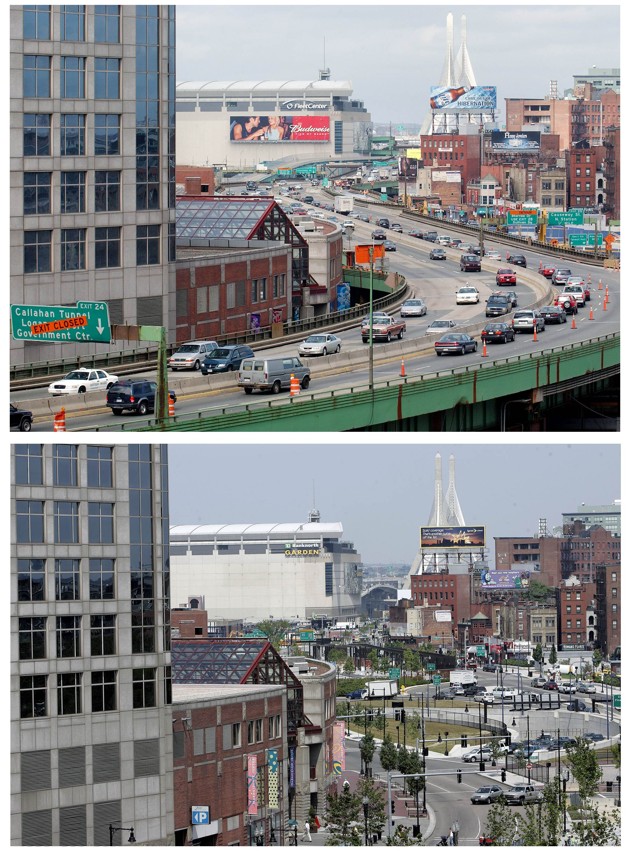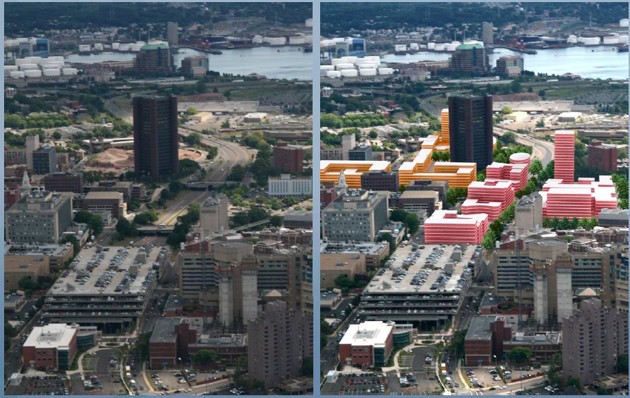Can tearing them down bring revitalization?
“This was a program which the twenty-first century will almost certainly judge to have had more influence on the shape and development of American cities, the distribution of population within metropolitan areas and across the nation as a whole, the location of industry and various kinds of employment opportunities,” Daniel Moynihan wrote in 1970 about the federal program that built these thousands of miles of highways.
But highways also created problems, some of which have become much worse in the years since. Urban freeways displaced communities and created air and noise pollution in downtown areas. They made it easier for suburban commuters to “zip to their suburban homes at the end of the work day, encouraging those with means to abandon the urban core,” Ted Shelton and Amanda Gann of the University of Tennessee wrote in a paper about urban freeways. They also encouraged a reliance on cars that has led to the traffic problems and commuting woes that are motivating a return to city cores.
“Where urban highway construction did occur, in urban design terms, it was highly detrimental to the urban fabric; creating physical and psychological rifts that are extremely difficult to bridge and introducing a substantial source of noise and air pollution,” Shelton and Gann wrote. “Cities across the country continue to struggle with this legacy.”
As some of the highways reach the end of their useful life, cities and counties are debating the idea of tearing down urban freeways and replacing them with boulevards, streets, and new neighborhoods. Though it might sound like a headache, tearing down freeways in city centers can reduce air pollution and create parks and public spaces that bring cities together, according to Shelton.
“The removal of urban interstates is a growing trend in the U.S.,” Shelton and Gann wrote. This trend, if carried to its logical extreme, can yield sites of intervention that hold the promise of remaking the American city.”
In Birmingham, for example planners want to see sections of I-20/59 replaced (though the state’s Dept of Transportation has different ideas). Many people in Buffalo, NY want to see the city’s Skyway torn down, and the Austin, Texas, city government has supported a resolution to submerge parts of I-35 and reconnect portions of city. Other urban highways potentially on the chopping block: the Aetna Viaduct in Hartford, Connecticut; Route 29 in Trenton, New Jersey; and Nashville’s downtown loop.
Some cities have already completed freeway teardowns. Boston, for instance, got rid of sections of I-93 as part of the Big Dig, putting parts of the freeway underground and creating more than 45 parks and public plazas. Voters rejected a plan to tear down the Embarcadero Freeway in San Francisco in 1986, but then the Loma Prieta earthquake damaged the highway, leading to its teardown anyway, a construction project that made the San Francisco waterfront more pedestrian-friendly. Milwaukee demolished the Park East freeway in 1999 and urban development has blossomed in the neighborhoods created by the highway’s removal. Manpower Corporation moved its headquarters to the area, and the average assessed land value there grew 45 percent.
It’s an important lesson for some of the nation’s most economically depressed cities, which are considering urban freeway removal projects as a means of economic development. New Haven, for instance, is in the midst of a project called Downtown Crossing, which has removed parts of Route 34 and is putting up new buildings in an area of town bisected by the freeway. The photos below show models of what the area looks like now, and what it will look like when the project is completed.
When the city put in Route 34 in the 1950s, it relocated 881 households and 350 businesses. It’s now hoping to bring businesses and residents back to the area. Already, the city is erecting a 425,000 square foot lab and office building, and Alexion Pharmaceuticals is in the process of building its new headquarters in the middle of this space, which will bring 1,000 jobs to the area.
“The goal of urban vitality and economic viability can be approached by utilizing portions of the right-of-way, from removing a major physical and visual barrier, to create development sites for mixed-use opportunities that will potentially improve the economy, increase tax revenues, and create new jobs,” the city wrote in its application for a federal grant.
Syracuse, New York, which has the highest concentration of black and Hispanic poverty in the country, is also debating a highway teardown. The highway I-81 bisected the city when it was completed in the 1960s, but has reached the end of its useful life, according to state Department of Transportation. The region is considering a number of options. Suburban residents and business owners want to see the elevated portions of the highway expanded or rebuilt. New Urbanists want the highway torn down and a boulevard constructed in a way that could encourage the development of pedestrian-friendly businesses and parks.
And the people that live near the highway? They just want to make sure that even if whatever happens next leads to large-scale changes in the city, they won’t be displaced like those who were their neighbors long ago.


No comments:
Post a Comment